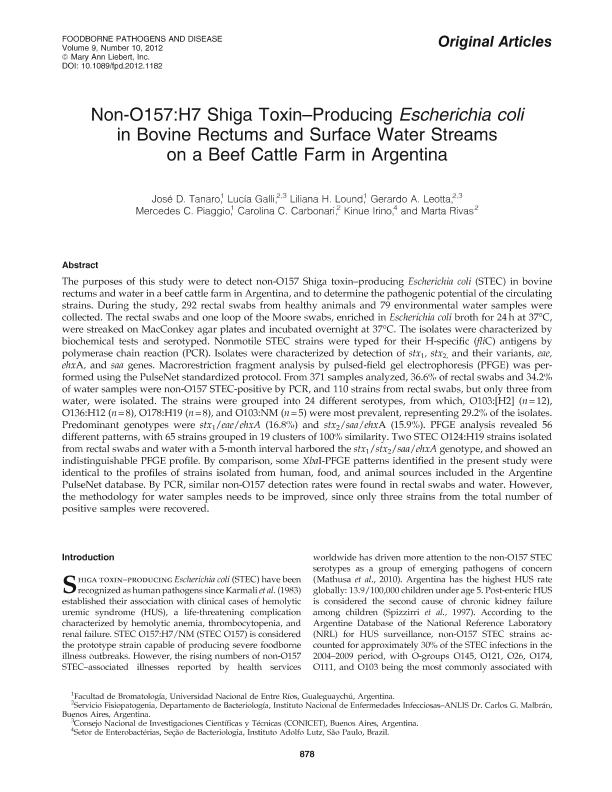Mostrar el registro sencillo del ítem
dc.contributor.author
Tanaro, José Daniel

dc.contributor.author
Galli, Lucía

dc.contributor.author
Lound, Liliana Haydee

dc.contributor.author
Leotta, Gerardo Anibal

dc.contributor.author
Piaggio, Mercedes Carolina

dc.contributor.author
Carbonari, Claudia Carolina

dc.contributor.author
Kinue, Irino
dc.contributor.author
Rivas, Marta

dc.date.available
2022-05-04T19:07:56Z
dc.date.issued
2012-10
dc.identifier.citation
Tanaro, José Daniel; Galli, Lucía; Lound, Liliana Haydee; Leotta, Gerardo Anibal; Piaggio, Mercedes Carolina; et al.; Non-O157:H7 Shiga Toxin Producing Escherichia coli in Bovine Rectums and Surface Water Streams on a Beef Cattle Farm in Argentina; Mary Ann Liebert; Foodborne Pathogens And Disease; 9; 10; 10-2012; 878-884
dc.identifier.issn
1535-3141
dc.identifier.uri
http://hdl.handle.net/11336/156531
dc.description.abstract
The purposes of this study were to detect non-O157 Shiga toxin-producing Escherichia coli (STEC) in bovine rectums and water in a beef cattle farm in Argentina, and to determine the pathogenic potential of the circulating strains. During the study, 292 rectal swabs from healthy animals and 79 environmental water samples were collected. The rectal swabs and one loop of the Moore swabs, enriched in Escherichia coli broth for 24 h at 37°C, were streaked on MacConkey agar plates and incubated overnight at 37°C. The isolates were characterized by biochemical tests and serotyped. Nonmotile STEC strains were typed for their H-specific (fliC) antigens by polymerase chain reaction (PCR). Isolates were characterized by detection of stx1, stx2, and their variants, eae, ehxA, and saa genes. Macrorestriction fragment analysis by pulsed-field gel electrophoresis (PFGE) was performed using the PulseNet standardized protocol. From 371 samples analyzed, 36.6% of rectal swabs and 34.2% of water samples were non-O157 STEC-positive by PCR, and 110 strains from rectal swabs, but only three from water, were isolated. The strains were grouped into 24 different serotypes, from which, O103:[H2] (n = 12), O136:H12 (n = 8), O178:H19 (n = 8), and O103:NM (n = 5) were most prevalent, representing 29.2% of the isolates. Predominant genotypes were stx1/eae/ehxA (16.8%) and stx2/saa/ehxA (15.9%). PFGE analysis revealed 56 different patterns, with 65 strains grouped in 19 clusters of 100% similarity. Two STEC O124:H19 strains isolated from rectal swabs and water with a 5-month interval harbored the stx1/stx2/saa/ehxA genotype, and showed an indistinguishable PFGE profile. By comparison, some XbaI-PFGE patterns identified in the present study were identical to the profiles of strains isolated from human, food, and animal sources included in the Argentine PulseNet database. By PCR, similar non-O157 detection rates were found in rectal swabs and water. However, the methodology for water samples needs to be improved, since only three strains from the total number of positive samples were recovered.
dc.format
application/pdf
dc.language.iso
eng
dc.publisher
Mary Ann Liebert

dc.rights
info:eu-repo/semantics/openAccess
dc.rights.uri
https://creativecommons.org/licenses/by-nc-sa/2.5/ar/
dc.subject
NON-O157 SHIGA TOXIN-PRODUCING ESCHERICHIA COLI (STEC)
dc.subject
BOVINE RECTUMS
dc.subject
WATER
dc.subject
POLYMERASE CHAIN REACTION
dc.subject.classification
Otras Ciencias Agrícolas

dc.subject.classification
Otras Ciencias Agrícolas

dc.subject.classification
CIENCIAS AGRÍCOLAS

dc.title
Non-O157:H7 Shiga Toxin Producing Escherichia coli in Bovine Rectums and Surface Water Streams on a Beef Cattle Farm in Argentina
dc.type
info:eu-repo/semantics/article
dc.type
info:ar-repo/semantics/artículo
dc.type
info:eu-repo/semantics/publishedVersion
dc.date.updated
2021-07-30T18:22:52Z
dc.journal.volume
9
dc.journal.number
10
dc.journal.pagination
878-884
dc.journal.pais
Estados Unidos

dc.journal.ciudad
New York
dc.description.fil
Fil: Tanaro, José Daniel. Universidad Nacional de Entre Ríos. Facultad de Bromatología; Argentina
dc.description.fil
Fil: Galli, Lucía. Dirección Nacional de Instituto de Investigación. Administración Nacional de Laboratorio e Instituto de Salud "Dr. C. G. Malbrán"; Argentina. Consejo Nacional de Investigaciones Científicas y Técnicas. Centro Científico Tecnológico CONICET- La Plata. Instituto de Genética Veterinaria "Ing. Fernando Noel Dulout". Universidad Nacional de La Plata. Facultad de Ciencias Veterinarias. Instituto de Genética Veterinaria; Argentina
dc.description.fil
Fil: Lound, Liliana Haydee. Universidad Nacional de Entre Ríos. Facultad de Bromatología; Argentina
dc.description.fil
Fil: Leotta, Gerardo Anibal. Dirección Nacional de Instituto de Investigación. Administración Nacional de Laboratorio e Instituto de Salud "Dr. C. G. Malbrán"; Argentina. Consejo Nacional de Investigaciones Científicas y Técnicas. Centro Científico Tecnológico CONICET- La Plata. Instituto de Genética Veterinaria "Ing. Fernando Noel Dulout". Universidad Nacional de La Plata. Facultad de Ciencias Veterinarias. Instituto de Genética Veterinaria; Argentina
dc.description.fil
Fil: Piaggio, Mercedes Carolina. Universidad Nacional de Entre Ríos. Facultad de Bromatología; Argentina
dc.description.fil
Fil: Carbonari, Claudia Carolina. Dirección Nacional de Instituto de Investigación. Administración Nacional de Laboratorio e Instituto de Salud "Dr. C. G. Malbrán"; Argentina
dc.description.fil
Fil: Kinue, Irino. Escola Nacional de Saude Publica Sergio Arouca; Brasil
dc.description.fil
Fil: Rivas, Marta. Dirección Nacional de Instituto de Investigación. Administración Nacional de Laboratorio e Instituto de Salud "Dr. C. G. Malbrán"; Argentina
dc.journal.title
Foodborne Pathogens And Disease

dc.relation.alternativeid
info:eu-repo/semantics/altIdentifier/url/http://www.ncbi.nlm.nih.gov/pubmed/22994915
dc.relation.alternativeid
info:eu-repo/semantics/altIdentifier/doi/http://dx.doi.org/10.1089/fpd.2012.1182
Archivos asociados
